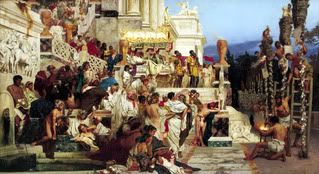Nero and the Burning of Rome
Despite his efforts to rebuild the city, rumours began to circulate in Rome that Nero had started the fire himself. Some of the population had received word of the Emperor’s supposed plans for Neropolis and believed that this was enough motivation for him to start the blaze and thus clear space in the city for his new project.
 The ancient sources carry conflicting accounts of whether the fire was started deliberately or was an accident. Suetonius and Cassius Dio point the finger at Nero as the culprit, burning the city in order to construct a new Imperial palace, whilst Tacitus says that Christians confessed to causing the blaze. If Nero had started the fire, it seems odd that he would have allowed it to destroy parts of his own palace, the Domus Transitoria. Modern archaeological work in Rome has also cast some doubt on the theory that Nero caused the blaze. Excavations have discovered that the fire began not on the site of Nero’s future villa the Domus Aurea, but 0.62 miles away on the other side of the Palatine Hill.
The ancient sources carry conflicting accounts of whether the fire was started deliberately or was an accident. Suetonius and Cassius Dio point the finger at Nero as the culprit, burning the city in order to construct a new Imperial palace, whilst Tacitus says that Christians confessed to causing the blaze. If Nero had started the fire, it seems odd that he would have allowed it to destroy parts of his own palace, the Domus Transitoria. Modern archaeological work in Rome has also cast some doubt on the theory that Nero caused the blaze. Excavations have discovered that the fire began not on the site of Nero’s future villa the Domus Aurea, but 0.62 miles away on the other side of the Palatine Hill.
Did Nero Persecute the Christians?
Nevertheless, after the catastrophe a significant part of Rome’s population still mistrusted Nero. Tacitus writes that to deflect the blame from himself, even if the fire had been an accident, Nero needed a scapegoat, and this was to be an obscure religious sect called the Christians. According to Tacitus, Nero began by arresting a few members of the sect who under torture implicated others in the crime.
Spreading the word that the Christians had burned Rome, Nero created huge resentment against the sect, who were mercilessly hunted down and put to death. Tacitus notes that Christians were convicted “not so much of the crime of firing the city, as of hatred against mankind” and that they were “covered with the skins of beasts, {and} . . . torn by dogs and perished, or were nailed to crosses, or were doomed to the flames and burnt” (Annals, 15.40).
Some traditions also associate the executions of St. Peter, crucified upside down on the Vatican hill, and St Paul, beheaded along the Via Ostiensis, with Nero’s persecution of Christians after the Great Fire. Professor Gerhard Baudy, of the University of Konstanz in Germany, believes that Nero was in fact correct in blaming the Christians for setting the blaze. His studies have shown that in the poor districts of Rome at the time of the fire Christians were circulating apocalyptic texts predicting that the city would be destroyed by a terrible inferno. Baudy claims that the Christians believed they were fulfilling divine prophesies and that the fire was part of a revolt to bring down the Roman Empire.
Not all ancient historians agree with Tacitus’s account of Nero’s relentless persecution of the Christians. Although Seutonius, who was born around AD 71, says that “punishment was inflicted on the Christians, a class of men given to a new and mischievous superstition” (Suetonius The Life of Nero, 16.2.) by Nero, this was not at the time of the Great Fire.
He mentions no persecution of the Christians after the fire at all, merely saying that Nero
made no effort, however, to find the authors; in fact, when some of them were reported to the senate by an informer, he forbade their being very severely punished.
(Life of Nero, 39.2.)
With as many as 100 minor fires breaking out every day in ancient Rome during the summer months, perhaps the Great Fire of Rome was the fault neither of Nero or the Christians after all, but a result of the poorly constructed wooden tenement buildings that covered much of the city. These building certainly allowed the fire to spread more rapidly.
The Decline of the Emperor Nero
Meanwhile Nero’s rule as Emperor soon began to crumble. In AD 65 he was alleged to have kicked his pregnant wife Poppaea to death, though it is just as likely that she died in childbirth. In AD 68 faced with a revolt from the Gallic and Spanish legions, along with the Praetorian Guards, Nero fled Rome. The senate declared him a public enemy and facing execution, on 9 June AD 68, he committed suicide with an iron blade. With the death of Nero, the Julio-Claudian dynasty finally came to an end.
Further Reading
Champlin, Edward. Nero. Harvard University Press, Harvard, Cambridge, Massachusetts, USA. 2003.
Griffin, Miriam. Nero: The End of a Dynasty. Routledge, London, UK. 2000.
http://www.pbs.org/wnet/secrets/previous_seasons/case_rome/index.html – ‘Secrets of the Dead – The Great Fire of Rome’. Public Broadcasting Service (PBS) website.
Read more about Nero and the Burning of Rome
in my book History’s Mysteries





